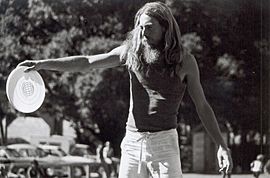Flying disc freestyle facts for kids
Flying disc freestyle, also known as freestyle Frisbee, is a super fun sport and performing art! It's all about doing cool, creative, and athletic tricks with a flying disc. Think of it like dancing or gymnastics, but with a disc! You can play freestyle by yourself or, more often, with friends. People play it just for fun or in exciting competitions.
The Freestyle Players Association (FPA) is like the main group that helps organize and grow freestyle disc play. They want more people to enjoy it as a hobby and a competitive sport. The FPA helps with international tournaments and player rankings. They also offer grants for education and promote the sport. Every year, the FPA holds a world championship where players compete in different categories, like pairs (two players) or co-op (three players). In competitions, judges watch how well players perform their tricks, how hard the tricks are, and how artistic their performance is.
Contents
Ready to Play?
You can play freestyle disc almost anywhere! People play indoors and outdoors, on grassy fields, and even at the beach. The way players do their tricks often changes depending on where they are, especially because of the wind.
When people play freestyle together, it's called a "jam." A jam can have anywhere from 2 to 15 people, but usually, it's about 2 to 5 players. If there are more than 4 or 5 people, it's sometimes called a "mob-op." When it's just two players, it's called "pairs," and with three players, it's "co-op."
What You Need to Play
Freestyle is usually played with a lighter disc, often around 160 grams. Some players use a special spray, like silicone, on the disc. This helps the disc spin smoothly on their fingernails for a trick called the "nail delay."
In competitions, many advanced players wear fake nails made from things like acrylic plastic, bone, or even antlers. They glue these onto their fingernails to help with tricks. But don't worry, you don't need these to start! There's also a faster version of freestyle, called "fast-freestyle," where you just throw and catch without any special equipment.
Awesome Tricks to Learn
Tipping the Disc
Tipping is when you gently poke the center of the disc with different parts of your body. This makes the disc "pop up" while keeping it spinning and at the same angle. You can tip with your fingertips, elbows, knees, feet, and even the top of your head! It's a cool way to keep the disc in the air.
Brushing the Disc
Brushing means you lightly swipe the disc with your hand, knee, or foot as it spins. You brush it along its edge, helping to control its movement.
Rolling the Disc

Rolling is when the disc moves smoothly across a part of your body. Ken Westerfield first showed this trick in 1975. The most common roll is the "chest roll." This is when the disc rolls from one hand, across your chest, to your other hand. You can then catch it or send it off for more tricks! Experienced players can do rolls across their front, back, and even legs, making cool combinations.
The Nail Delay
The nail delay is a key trick where you balance the spinning disc on your fingernail. You can also balance it on your teeth, feet, or elbows! This trick lets you move the disc around precisely. You can hold the disc vertically, at an angle, or even flat on your nail. Most players prefer the disc to spin either clockwise or counterclockwise, but advanced players can do tricks with both spins. The nail delay is a big part of modern freestyle, allowing for super tricky moves like "turnovers."
Turning Over the Disc
A turnover is when you flip the disc from being right-side up to upside-down. This is a technical trick that needs good balance and a "pivot point" (a spot where the disc can turn). Usually, when you do a turnover, the disc's spin changes direction. For example, if it was spinning clockwise, it might switch to counterclockwise. This is because of how the disc moves and spins in the air.
Cool Catches
Freestyle catches are often split into two types: blind and restricted.
- Blind catches are when you can't see the disc as it enters your hand. Popular blind catches include the "scarecrow" and "phlaud."
- Restricted catches mean you position your hand around a part of your body, like under your leg or behind your back. One very famous catch is called "gitis." For this, you catch the disc with one hand reaching over and around your opposite leg. You can also catch the disc between your legs or by resting it on your back.
Awesome Throws
Freestylers use many different kinds of throws to make their routines more difficult and stylish. These throws also create different spins and angles for the disc. Basic throws include the backhand, sidearm (forehand), and overhand wrist-flip. More advanced throws can be blind (you don't see where you're throwing), restricted (your body is in the way), or special "MAC throws." A MAC throw is when you hit the top of the disc in mid-air with a free hand, foot, or elbow. This adds extra spin, slows the disc down, and changes its angle!
Big Freestyle Events
- FPA Worlds
- World Urban Games
- Paganello
- World Flying Disc Federation (WFDF) Championship
- EFC – European Freestyle Championships


